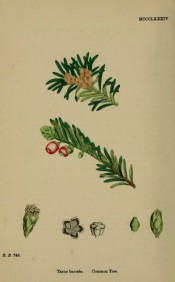Taxus baccata L.
Fully-hardy, broadly conical evergreen tree with spreading, horizontal branches, purple-brown bark, linear dark green, 2-ranked leaves, to 3cm long, and red fruit, to 1cm across. To 20m. [RHSE, Hortus, Hilliers’].
Horticultural & Botanical History
Ancient garden plant long used for hedging and as a specimen tree. Its timber was valuable for making bows and it was frequently grown in church yards to protect stock as all parts, particularly leaves and berries, are poisonous. ‘The Yew (Taxus baccata) - This funereal-looking plant belongs to the Gymnosperms and calls for careful consideration, as it is reckoned to be the most dangerous tree for cattle that we possess in Great Britain. It is commonly found in burial-places, and the reason for this is alleged to be, that as the preservation of the Yew in the Middle Ages was a matter of importance, because its branches were used for the making of bows, the burial ground was chosen on account of its sanctity, which would probably ensure a freedom from damage to all the plants growing within the enclosure. […].
As drying does not weaken the poisonous properties of the leaves, and as there is no warning signal in the form of an unpleasant taste or smell, the leaves and berries constitute a real danger to cattle and to children. In winter especially, cattle will readily browse on the leaves. Not only the leaves and berries, but also the wood and bark are poisonous, although the leaves, and especially the older ones, are the most dangerous. One case is on record in which three horses, taken to be sold at a country fair, had been tethered to the churchyard railings, and had whilst there eaten Yew boughs; all three died from the effects. There are records which show that not only horses, but asses, cows, and rabbits have been poisoned by this plant. The scarlet covering to the seed is not harmful when ripe, but the seed itself is deadly poisonous. It is said that on one occasion on which thirty-two persons had by accident partaken of Yew seeds and leaves, twenty died of the poison. Henslow states that several cases are on record of inmates of lunatic asylums having died after chewing Yew leaves. The active principles are a bitter alkaloid called taxine, which evolves an aromatic odour, and a crystalline alkaloid called milossine.’ [Medicinal Herbs and Poisonous Plants. Ellis. p.154/1918]. Leaves, flowers and fruits are figured in English Botany. [English Botany vol.VIII, pl.MCCCLXXXIV/1868].
History at Camden Park
Listed in the 1850 and 1857 catalogues [C.85/1850]. The first record is a desideratum to Loddiges’ Nursery on 6th January 1845. [MP A2933-2, p.28].
Notes
Taxus baccata Thunb. (1784) = Cephalotaxus drupacea Siebold & Zucc.
Taxus baccata Hook. (1838) = Taxus brevifolia Nutt.
Published Jan 25, 2009 - 03:35 PM | Last updated Jul 31, 2010 - 04:40 PM
| Family | Taxaceae |
|---|---|
| Category | |
| Region of origin | Europe, North Africa to the Middle East |
| Synonyms | |
| Common Name | Common yew, English yew |
| Name in the Camden Park Record | Taxus baccata |
| Confidence level | high |


